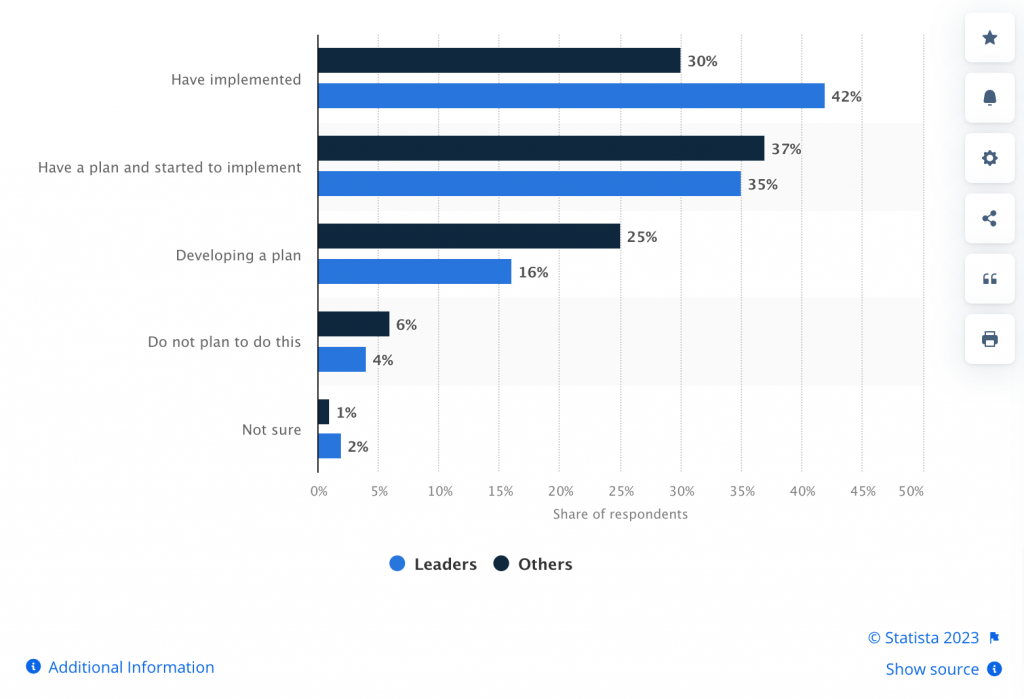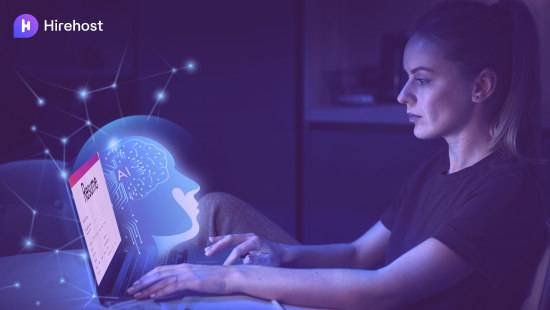AI in Recruiting: A Guide for HR Professionals Elevating Hiring

Artificial intelligence (AI) is bringing major shifts in every industry, and recruitment is no exception. From more streamlined hiring to increased efficiency to enhanced candidate experience, it’s fundamentally impacting the entire recruitment process. A survey reveals that over 95% of leading companies have either adopted AI or developed plans to utilize it, aiming to enhance their hiring policies and meet evolving needs.
If you’re keen on understanding and implementing this new paradigm for a future-ready talent acquisition approach, this guide is just for you. In this post, we’ll go through what is AI in recruiting, explore its benefits and potential challenges, showcase real-world examples, debunk some myths, and provide actionable steps to integrate AI into your recruitment strategy.

What is AI in recruiting
AI in recruiting incorporates artificial intelligence technologies to optimize the hiring process. Essentially, it streamlines tasks that have traditionally been time-consuming, thereby improving the hiring process and its outcomes.
For instance, leveraging advanced algorithms, machine learning, and data analytics, AI automates repetitive tasks like resume screening, candidate sourcing, and initial interview stages. Moreover, it goes beyond mere automation by adding a layer of intelligence. It learns from historical data to identify patterns and predict successful candidate matches. This not only accelerates the recruitment timeline but also enhances the quality of candidate selection.
Benefits of AI in recruiting
AI offers numerous advantages that can elevate a company’s recruitment process to the next level. The following highlights the key benefits:
Removes biases
In a survey, 43% of participants emphasized the key advantage of AI in recruitment—eliminating human bias. By focusing on skills, qualifications, and experience rather than personal characteristics, AI significantly reduces unconscious bias, fostering a more diverse and inclusive workforce.
Enhances candidate experience
Incorporating AI into the job application process streamlines and accelerates the candidate experience. With features such as instant responses, real-time updates, and 24/7 accessibility, AI ensures a seamless journey for job seekers. Additionally, tools optimizing interview scheduling and providing prompt feedback not only enhance efficiency but also contribute to a positive company image. Furthermore, AI saves time for recruiters, enabling them to establish personal connections with candidates and foster a friendlier and more engaging recruitment environment.
Improves hiring quality
AI can help improve the hiring quality by helping you find the right candidates for the jobs. With data-driven insights, AI makes the screening and selection process way more efficient. You can use AI to attract the ideal candidates by optimizing job posts, descriptions, and interview questions that exactly match your needs. Further, AI can also help you target specific job markets and candidates to find the right fit for the job.
Reduces costs
AI diminishes the need for additional recruiters, interviewers, or employees. Automating tasks and enhancing efficiency, minimizes time and financial investments in recruitment. Importantly, it reduces employee turnover, saving significant expenses related to hiring, onboarding, and training.
Saves time
Recruitment involves various time-consuming stages and tasks. AI automation expedites the entire hiring process, allowing recruiters to redirect their time to crucial, strategic, and people-oriented aspects of their job.
Challenges of AI in recruiting
While AI offers numerous advantages to recruiting, it also presents challenges that require careful consideration. Understanding these challenges can enable you to effectively address them, ensuring that AI contributes positively to the hiring process.
Requires a lot of data
AI requires a lot of data to learn how to accurately mimic human intelligence. For example, AI that uses machine learning needs a lot of data to learn how to screen resumes as accurately as a human recruiter. This can mean several hundred to several thousands of resumes for a specific role. Collecting and organizing this data can be time-consuming and expensive.
Integration with existing processes
Integrating AI with existing processes can be challenging, especially if the current processes are outdated or not well-documented. This can lead to resistance from recruiters and HR professionals who are used to working in a certain way.
Lacks human aspect
While AI is great at speeding up the process such as screening and providing instant feedback, a recruiter still needs to create an authentic candidate relationship. Candidates may feel uncomfortable interacting with a machine, and they may prefer to speak with a human recruiter.
Can learn human biases
If the AI is not configured properly, it could keep using the existing biases in our hiring practices. For instance, if the system learns from data containing unfair hiring decisions, it may continue recommending similar biased choices to decision-makers.
Examples of AI in recruiting
AI significantly streamlines various tasks and processes in the hiring domain. Below are some widely used and effective examples of AI in recruitment:
Application tracking system
An Applicant Tracking System (ATS) is intelligent software that assists in the hiring process. Utilizing AI, an ATS efficiently manages job ad postings and handles applications. It simplifies the recruiter’s tasks by screening and shortlisting resumes, identifying keywords to streamline the selection process.
Chatbot and virtual assistants
Chatbots and virtual assistants serve as AI helpers who engage in conversations with people, playing a pivotal role in enhancing the AI recruiting landscape. These intelligent assistants prove highly beneficial for candidates by handling mundane tasks and improving the overall recruitment efficiency. They engage in conversations, perform administrative duties, assess candidate-job compatibility, offer valuable insights, and contribute to an exceptional candidate experience.
Skill assessment platform
Skill Assessment Platforms act like smart assistants that use AI to understand how skilled someone is in technical areas, their thinking abilities, and how well they handle soft skills. These platforms achieve this by having candidates take different tests and simulations. They provide a helpful way to get clear, unbiased information about what a candidate can do, assisting companies in making informed, data-driven decisions during the hiring process.
Video interview analysis
Video Interview Analysis is a way of using Artificial Intelligence (AI) to assess job candidates based on their video interviews. In this process, candidates respond to pre-set questions in a one-way video interview, and the AI system then analyzes their recording through algorithms to evaluate their performance. The AI software utilizes natural language processing (NLP) to assess video interview transcripts, eliminating the need for recruiters to be physically present during the analysis.
Myths about AI in recruiting
The increasing role of AI in recruiting has also sparked numerous myths and misconceptions. Contrary to these beliefs, AI isn’t here to replace but to empower recruiters, making the hiring process more efficient and accessible for businesses of all sizes. Let’s unravel the facts and demystify the myths surrounding AI in recruiting.
Myth 1: AI will replace recruiters
This is perhaps the most pervasive and intimidating myth about AI. A recent survey found that 79% of recruiters believe people won’t need to be involved in the recruiting process shortly. However, the fact is that AI will not replace recruiters but will assist them in completing business procedures and becoming more proactive.
Myth 2: AI in recruitment is difficult to understand
At first, using AI recruitment technology might seem a bit complicated. But, the tools themselves aren’t hard to handle. It just takes a bit of time and effort to get the hang of them. Once recruiters and their teams understand the software well, they can reach out to a wider pool of talent and cut down on the time spent finding new people. That means more time can be put into getting new hires on board smoothly.
Myth 3: AI recruitment tech is only for big companies
Contrary to this belief, AI is a game-changer for businesses of all sizes. While large companies may have more resources to invest in AI, small and medium-sized businesses can also benefit from AI recruitment technology.
Preparing yourself and your organization for AI in recruiting
Now that you’ve gained insights into AI in recruiting and how it can be a game-changer for your talent acquisition needs, it’s time to prepare yourself for getting started. Here are some tips to help you begin.
Educate yourself
Before integrating AI into your recruiting practices, gather your team for a discussion on how you intend to leverage AI-powered tools collaboratively. Establish clear policies regarding the types of information utilized by and provided to AI. Define the boundaries for its use, outlining specific purposes it will serve and those it won’t.
Assess your needs
Assessing your needs is an important step in preparing for AI in recruiting. Begin by identifying the specific areas in your recruitment process that could benefit from AI integration, such as resume screening, candidate sourcing, or interview scheduling. Determine the main pain points that AI can help address within your current recruitment workflow. Engage with primary stakeholders, HR teams, and hiring managers to gain insights into problem areas and where AI can make a significant impact. Based on the assessment, identify areas within the recruitment process that can benefit most from AI technology.
Evaluate AI solutions
When preparing for AI in recruiting, it’s crucial to assess various AI solutions and vendors to identify those that align most effectively with your organization’s requirements and budget. This involves conducting thorough research and comparing platforms based on their features, support, and training options. By carefully evaluating these aspects, you can make informed decisions that ensure the seamless integration of AI technology into your recruiting processes, optimizing efficiency and meeting the unique demands of your organization.
Training and familiarization
Provide training and resources to your HR team to familiarize them with the AI tools and technologies you plan to implement. Encourage them to understand AI’s functionalities and potential uses in their day-to-day recruitment tasks. Familiarizing your HR team with AI tools and technologies is essential for successful integration and utilization. This training will empower your team to leverage AI effectively, optimize recruitment processes, and make informed decisions.
Continuous monitoring and evaluation
Continuously monitoring and evaluating the performance of AI tools and their impact on the recruitment process is essential. Regularly tracking relevant recruitment KPIs (key performance indicators) is crucial to measuring the success of AI integration. Additionally, analyzing data on time-to-hire, candidate quality, diversity metrics, and cost-per-hire can identify areas for improvement and optimize the recruitment process. This ongoing analysis ensures that AI tools effectively contribute to the organization’s hiring objectives, allowing for adjustments that enhance overall efficiency and outcomes.
Conclusion
The use of AI in recruiting is incredibly exciting, revolutionizing how companies hire new team members. These AI-powered tools handle redundant task and ensure the ideal match between jobs and people. This not only saves businesses time and money but also enhances accuracy, resulting in superior hires. The evolving intelligence of AI promises even more innovative and creative recruiting tools in the future, opening up exciting possibilities for further advancements in the hiring process.
Other Blogs

How to Use ChatGPT for Resume: A Comprehensive Guide
Considering using ChatGPT to compose your resume? You're in good company—almost half of job seekers have given it a shot.…

What Does a Chief of Staff Do: Revealing Their Responsibilities and Role
Summary: New CEOs usually concentrate on developing and executing strategies, assembling a strong leadership team, and instigating cultural shifts. Streamlining…
The Next Big Thing:
Invest in HireHost Today
Invest in our product and let’s grow together
